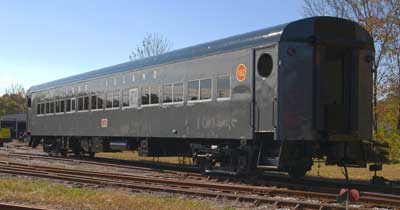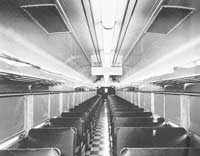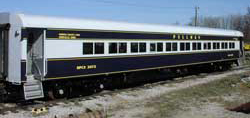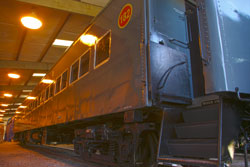
The Long Island fresh from the paint shop.
"The Long Island"
Built between 1955 and 1956, LI No. 2972 was one of 55 identical cars ordered by the Long Island Railroad. These cars were 120-seat, commuter coaches. They were constructed using the P-S girder design with smooth, painted exterior sides, and rode on 41-BNP (CIB) trucks equipped with Hyatt 5-1/2” X 10” roller bearings. The were equipped with remote control sliding doors. The interiors featured 3 person and 2 person, walkover seats and checkered linoleum floor tile. Lighting came from a continuous fluorescent strip down the center of the ceiling. Luggage racks were interspersed with advertising cardholders. On each end were manual sliding doors. The Heart of Dixie Railroad Museum operates Commuter Coach No. 2972, while the Hoosier Valley Railroad Museum, in North Judson, Indiana, operates another of the original 55, Commuter Coach No. 2937.

The interior of a 120-seat, commuter coach
Post World War II Passenger Service
Passenger rail service after the Second World War faced competition from the automobile and improved air travel. These factors contributed to a dramatic decline in rail travel. Because the Long Island Railroad served the greater New York area, passengers continued to travel by train due to a commuter culture mentality.
The Toonerville Trolley Perception
Despite the doubling of operating cost since 1917, the Long Island Railroad had not been allowed to increase fare costs due to existing regulations. As a result, previous owners had not invested in new equipment. By the 1950s most of the rolling stock in use on a daily basis dated from the 1900s. Aside from the constant breakdowns brought on by outdated and worn equipment, the ergonomics of the passenger cars were designed at a time when an average person was shorter and weighed less. This made for cramped travel for commuters, leading to the nickname “Toonerville Trolley.”
 Steps to Modernization
Steps to Modernization
Despite its continued financial struggles, the railroad realized they needed to modernize. The plan that evolved consisted of phasing out the existing steam locomotive power in favor of new diesels, purchasing 222 new cars for passenger service, and refurbishing existing cars. In a move to publicize their commitment to update the fleet, the Long Island Railroad developed a graphic system to distinguish new and refurbished cars. The Long Island Railroad started its Modernization Number program in December 1954. New cars were marked with a red circle with yellow numbers and borders. The number in the circle indicated the order in which the car had been received. Coach Car No. 2927 was the 182nd car delivered and carried the number 182. Refurbished cars were given a yellow circle with red numbers and borders.
 Metropolitan Transportation Authority
Metropolitan Transportation Authority
By 1967 the ownership of the Long Island Railroad changed. The Long Island Railroad was now part of a New York State Agency called the MTA (Metropolitan Transportation Authority). During this time the car was painted a platinum mist with blue stripes and lettering.
New Seating
This series of cars was originally built with 3 person and 2 person walkover seats that could be flip flopped to change the direction the passengers faced depending on the direction the train was traveling. These seats were changed out during the early 80’s to the more modern style you see in the car today. The new seating was vastly more comfortable than the original seating although the passengers were relegated into sitting facing whatever direction the car happened to be when it was put in the train. During this rebuild, the car was equipped with safety escape windows and the blue stripe on the exterior was lowered. At this same time the green tinted windows that were added in the 1960s were changed out to the standard tint windows you see now. The green windows gave the passengers the feeling of looking through murky water.

The Long Island when delivered to the HOD Museum
Acquired by Heart of Dixie
The car was acquired from a private individual in 2005. The individual had bought the car directly from the MTA when the car was being retired. During this time, the owner altered the seating. Some seats were turned to face one another and some removed for more legroom. This was done to make the car conducive to the type excursions the car was being used. It worked out that this made the car perfectly suited for excursions with the Heart of Dixie.
A New Lease of Life

Emerging from the Museum’s shop showing original Long Island Railroad colors
In 2012, No. 2972 entered the Calera & Shelby shop to have the floor rebuilt and the seating reupholstered. The following year, 2013, repairs were made to the vestibules and steps and new windows were installed. Finally, the exterior was painted duplicating the color scheme No. 2972 and her sisters wore the day they entered service. The No. 2972 has proven to be a workhorse having operated in virtually all of the museums trains, except when in the shop for various upgrades. The car should continue to provide excellent service for many years to come.


